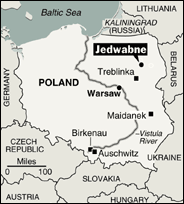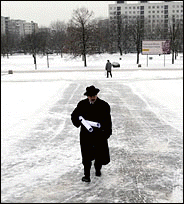January
9, 2003 -- WARSAW. Several times a week, the tour buses
pull up to the monument to the 1943 Warsaw ghetto
uprising, spilling out dozens of Israeli students or
military cadets for a brief ceremony to honor the Jewish
victims of the Holocaust.
Each year, more
than 100,000 Israeli and American Jews visit Poland,
viewing plaques that mark significant sites in the
wartime ghetto and visiting former Nazi death camps at
Auschwitz, Treblinka, Birkenau or Maidanek, where three
million Polish Jews and millions of other Jews were put
to death.
The visitors
come to honor the memory of the lost Jews, but they see
little more of the country, in which Jewish life was
effectively destroyed. As Foreign Minister Wlodzimierz
Cimosziewicz noted in a recent interview, "These visits
result in them perceiving Poland as just one big
cemetery" for Jews.
Now, with the
government's support, a group has drawn up plans for a
$60 million interactive Museum of the History of Polish
Jews, to rise this decade just yards from the memorial in
the heart of the former ghetto.
The American
architect Frank Gehry, the son of Jews who emigrated from
Poland before 1939, will design the building.
The idea for the
museum grew in part out of the extraordinary searching of
the national soul that followed the revelations two years
ago that the Jewish residents of the town of Jedwabne
were killed by Polish villagers, not occupying
Nazis.
Much as Roman
Polanski's current film "The Pianist" showed that some
shred of Jewish life and Polish decency survived World
War II, this museum is an effort to show that for eight
centuries, Poland was a vibrant center of Jewish
culture.

In the early 20th
century Warsaw's Jewish quarter was vibrant.
By 1945, a Catholic church towered over the rubble of the
ruined district.
Today, Poland is
a country of 39 million people with only about 15,000
Jews. But on the eve of World War II, one in 10 Poles was
Jewish, with Jews constituting up to one-third of the
population of cities like Warsaw.
"We can't tell
two stories, the history of Poland and the history of the
Jews, because simply they exist together and they must be
told together," said Ewa Junczyk-Ziomecka, who leads the
fund-raising effort for the museum.
Supporters of
the project, who include Jews and non-Jews, see it also
as an attempt to counter the widespread image of Poland
as a deeply anti-Semitic country --an image burnished
after World War II by anti-Jewish riots and the expulsion
by the then ruling Communists of about 20,000 remaining
Polish Jews in
1968.
|
|

|
|
Findings
that poles killed Jews in Jedwabne led to new
examination.
|
Some Polish
intellectuals say the country has started to face its
past.
"This really
happened with Jedwabne," said Stanislaw Krajewski, a
professor of logic at Warsaw University and a member of
the board of the Union of Polish Jewish Communities.
"Everything has been said, there are no taboos. All the
things of Poles murdering their neighbors have been
discussed, and no one can say `I haven't heard about it,'
as they could have even two years ago."
But the
situation is still complicated. Poland's Catholic
primate, Jozef Glemp, the cardinal of Warsaw, has long
taken an equivocal stance on anti-Semitism. When
President Aleksander Kwasniewski traveled to Jedwabne in
2001 to make a formal apology to Jews on behalf of
Poland, Cardinal Glemp refused to join him.
Meanwhile, the
rabidly anti-Semitic radio station Radio Maryja, run by
the Rev. Tadeusz Rydzyk, has remained widely popular. And
in Gdansk, the Rev. Henryk Jankowski continues to preach
anti-Semitic sermons at the church of St. Brygida with
little rebuke from his church superiors.
Jews began
settling Poland in significant numbers in the 13th
century; by the 16th century, they were the first Jews in
Europe to win the right to self rule.
Poland was home
to some of Judaism's greatest scholars and Yeshivas, or
religious schools. Many of Poland's prominent cultural
figures have been Jewish, including Mr. Polanski, the
pianist Arthur Rubinstein, and the author Isaac Bashevis
Singer. Much of Europe's richest Jewish culture emerged
from Poland &emdash; from medieval scholars to the
mystical Hasidic movement.
"Until 1900,
when New York replaced it, Warsaw was the heart of the
global Jewish diaspora," Ms. Junczyk-Ziomecka
said.
Museum exhibits
will include a recreation of a Warsaw street from this
golden age, a theater with a recreated performance, a
virtual synagogue, and a recreation of the Warsaw ghetto
itself.
Historians have
spent several years creating an electronic archive of
documents, official registers and family photographs from
Poland's now-vanished Jewish communities that will be
part of the exhibit.
Supporters say
the museum must be built quickly, before the last of
those who remember Poland's rich Jewish heritage are
gone.
"We won't be
alive much longer to tell people about it. We must leave
something behind," said Wladyslaw Bartoszewski, the
former Polish foreign minister who during World War II
was liaison between the Polish underground and the Warsaw
ghetto. He was named a "righteous gentile" by Israel for
his efforts.

|
|
|
Jerzy
Halbersztadt, the project director for a planned
Jewish museum, walks the exhibit's future site,
where Warsaw's Jewish ghetto once
stood.
|
Jerzy
Halbersztadt, a prominent historian who has been named
the museum's project director, said the new museum is
needed in order to ensure that the conversation about
Poland's past that began with the Jedwabne revelations is
continued.
"A lot has
changed in the knowledge and attitudes of Jews towards
Poles and Poles towards Jews," Mr. Halbersztadt said.
"But mainly it is limited to the elites. What is needed
is mass education, and in my opinion it is needed on both
sides."
Even among
supporters of the museum, there are those who worry that
it looks too much to the past.
"I am sick and
tired of people burying me, even with the best intentions
in the world," said Konstanty Gebert, editor of the
Jewish monthly magazine Midrasz.
He suggested
that some of the museum's money should go to help build
Poland's Jewish community, like supporting Jewish
elementary schools in Warsaw and Wroclaw or helping young
people who are rediscovering their Jewish
origins.
"It is wonderful
that they are building the museum, that the history of
Polish Jews will not fade into oblivion, and that Polish
kids will go there and it will help fight anti-Semitism,"
said Malgorzata Szymanska, a 22-year-old who helped found
a liberal Jewish community in Warsaw. "But that's a lot
of money to put into history. Why don't they see that
there are Jewish people who want to continue Judaism, who
are fighting to be Jewish?"


